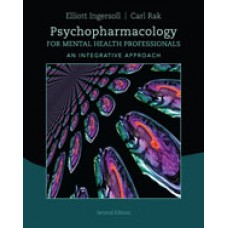This is completed downloadable of Test Bank for Psychopharmacology for Mental Health Professionals An Integrative Approach, 2nd Edition

Product Details:
- ISBN-10 : 1285845226
- ISBN-13 : 978-1285845227
- Author: Elliott Ingersoll, Dr. Carl Rak
Master the basics of psychopharmacology with PSYCHOPHARMACOLOGY FOR MENTAL HEALTH PROFESSIONALS, Second Edition. Concise yet comprehensive, this counseling text covers the basic principles of psychopharmacology, commonly prescribed psychotropic drugs for adults, and psychotropic medications prescribed to children. Psychological, cultural, and social issues related to psychopharmacology are also addressed. Numerous case examples, study questions, bolded key terms, and a glossary help you understand and applying the material. Practical information about how to talk with clients about medication and compliance as well as hands-on information about how to approach collaboration with prescribing professionals prepares you to apply what you have learned to practice. This edition includes new material on psychosocial treatments that complement the most prescribed medications, expanded discussion of medication of children and the elderly, a new chapter on drug replacement therapies, reference to changes in the DSM-5, and more.
Table of Content:
- Part 1: An Overview of the New Edition
- Ch 1: Introduction
- Encouragement to the Reader
- A Mantra
- Scientific Truth and the Acceleration of Knowledge
- Chapter One: Section Two
- Psychopharmacology and Magical Thinking
- Moving on: What We Know, What We Do Not Know
- The Mind-Brain Problem
- The Layout of This Book
- Study Questions and Exercises
- Ch 2: Introduction to the Nervous System, Neurons, and Pharmacodynamics
- Introduction
- Section One: An Overview of Physiology Relevant to Psychopharmacology
- A Few Basics
- Section Two: Exploring the Central Nervous System
- Section Three: An Overview of Neurons and Glial Cells
- The Basic Anatomy of a Neuron
- Glial Cells
- The Blood-Brain Barrier
- Section Four: Types of Neurotransmitters
- Glutamate (Glu)
- Gamma-Aminobutyric Acid (GABA)
- Acetylcholine (Ach)
- Monoamine Neurotransmitters
- Dopamine (DA)
- Norepinephrine (NE)
- Serotonin (5-HT)
- Reality is Complex and …
- Section Five: The Story of Neurotransmission
- Neurotransmission: The Team Players
- Back to Neurotransmitters
- Ions
- Ion Channels
- A View within the Cell
- The Process of Neurotransmission
- First-Messenger Effects
- Second-Messenger Effects
- A Quick Review
- What Happens When Neurotransmitters Bind to Receptors?
- What Happens to the Released Neurotransmitter?
- Section Six: Pharmacodynamics or How Psychotropic Medications Affect Neurotransmission
- Agonism and Antagonism
- Mechanisms of Action with Effects on Production
- Mechanisms of Action with Effects on Release of Neurotransmitter
- Mechanisms of Action Targeting Neurotransmitter Deactivation
- Summary
- Case of Colleen
- Class Exercise: The Psychodramatic Neuron
- Study Questions and Exercises
- Ch 3: Pharmacokinetics: How the Body Acts on Psychotropic Medications
- Section One: Drug Absorption
- Section Two: Getting to the Bloodstream
- Section Three: Drug Distribution
- Section Four: Drug Binding and Types of Tolerance
- Section Five: Elimination of Drugs
- Case
- Ch 4: Psychological, Social, and Cultural Issues in Psychopharmacology
- Section One: Adherence and Compliance with Medication Regimens
- Client Reactions to the Medical Model of Mental Illness
- Compliance and Adherence
- Reasons that Clients May Not Comply
- Section Two: Talking to Clients about Medications: Know and Educate Thyself
- Specific Supervision Issues
- Assessment
- Monitoring
- Advocacy
- Summary
- Section Three: Ethno-Psychopharmacology: Group Differences in Response to Psychotropic Agents
- Sex Differences
- Racial Differences
- A Focus on the Cultural Perspective
- Case Study: The Case of Rafael
- Case
- A Meeting of Subcultures: Collaboration with Prescribing Professionals
- Section Four: Social Institutions and Their Impact on Psychotropic Medications
- Pharmacoeconomics
- Conclusion
- Summary
- Study Questions and Exercises
- Part 2: Introduction
- Ch 5: The Antidepressant Era
- Section One: The Current Impact of Antidepressants
- Major Depressive Disorder (MDD)
- Comorbidity of Depression and Anxiety
- Antidepressant Efficacy
- Section Two: Theories of Antidepressant Action
- Section Three: The Neurotrophic/Plasticity Hypothesis and New Theories of Antidepressant Action
- Newer Hypotheses and Theories
- Toward an Integrative Theory of Antidepressant Action
- Section Four: Overview of First-Generation Antidepressant Medications
- Tricyclic Antidepressants
- Section Five: Second Generation Antidepressants: Selective Serotonin Reuptake Inhibitors
- Psychological and Cultural Issues with SSRIs
- Section Six: Third-Generation Antidepressants
- Desvenlafaxine/Prestiq
- Brintellix/Vortioxetine
- Milnacipran/Savella
- Into the Future: Ketamine
- Summary Points about Antidepressants
- Case of Joshua
- Antidepressants in Older Clients
- Section Seven: Focus on Psychological, Cultural, and Social Perspectives
- Psychological Perspectives
- Different Perspectives on the Placebo Problem
- Other Treatments for Depression
- A Problem Case: The Case of Alex
- Summary
- Study Questions and Exercises
- Ch 6: The Age of Anxiety
- Section One: Overview of Anxiolytic Medication and the Construct of Anxiety
- Theories of Anxiolytic Action
- Section Two: The Central Nervous System: Anxiety, Brain Circuits, Brain Structures, and Neurotransmi
- Section Three: Central Nervous System Depressants
- Benzodiazepines
- Section Four: Nonbenzodiazepine Alternatives
- Hypnotics
- Buspirone: A Unique Anxiolytic
- Section Five: Newer Approaches to Anxiolytic Medications
- Section Six: SSRI Treatment of Anxiety
- Section Seven: Anxiolytic Therapy by Diagnosis
- Section Eight: Focus on Psychological, Cultural, and Social Issues
- Psychological Issues
- Summary
- Ch 7: Antipsychotic Medications: The Evolution of Treatment
- The Current Impact of Antipsychotics
- Section One: Schizophrenia
- Section Two: Theories of Neuroleptic Action from the Medical Model Perspective
- The Case of Colin
- The Case of Ethel
- The Case of Teana
- The Case of Maurice
- Section Four: Clozaril: The Prototype for Atypical Antipsychotics
- The Case of Bonnie
- A New Era
- Section Five: The Serotonin/Dopamine Antagonists
- The Case of Melanie
- Section Six: Newer Agents
- Section Seven: Focus on Other Perspectives
- Psychological Considerations
- Summary
- Ch 8: Mood Stabilizers
- Section One: Mood Misnomers
- Section Two: Bipolar I Disorder
- Section Three: Some History on Mood Stabilizers
- Section Four: Lithium: The Prototypical Mood Stabilizer
- Section Five: Anticonvulsants as Mood Stabilizers
- Oxcarbazepine/Trileptal
- The Case of Molly
- The Case of Roger
- Valproic Acid
- The Case of Jose
- The Case of Beverly
- Section Six: Newer Anticonvulsants as Mood Stabilizers
- Section Seven: Atypical Antipsychotics as Mood Stabilizers
- General Conclusions on Mood Stabilizers
- Section Seven: Issues from Other Perspectives
- Section Eight: Issues from the Cultural and Social Perspectives
- Conclusion
- Summary
- Part 3: Newer Issues
- Ch 9: Medicating Children
- Section One: Perspectives, Dilemmas, and Future Paradigms
- The Complex State of Therapy
- The Explosion of Psychotropic Medication Prescriptions for Children and Adolescents
- The Case of Phillip
- The Medication of Children and the Federal Laws
- A Word on Cross-Cultural Perspectives
- Psychological Perspectives of Children and Adolescents
- Opposition to the Current Trend of Medicating
- An Overview of Pediatric and Adolescent Psychopharmacology
- Section Two: Stimulant Medication
- Section Three: ADHD and Combined Interventions
- Section Four: Mood Stabilizers and Bipolar I Disorder in Children
- The Case of Nicole
- Section Five: Children and Antipsychotic Medication
- Section Six: Antianxiety Medications and Children and Adolescents
- School Issues, Anxiety, and Children
- Section Seven: Antidepressants and Children and Adolescents
- The Placebo Problem
- Conclusion
- Summary
- Ch 10: Herbaceuticals
- The Behavior of Herbaceutical Use
- Section One: Psychological Issues
- Section Two: Issues of Culture
- Section Three: Issues from the Social Perspective
- Section Four: Problems in Studying Medicinal Plants
- Differences between Herbs and Drugs
- Section Five: Examining Better Known Herbaceuticals with Application for Psychiatric Problems
- Section Six: An Integrative View of Marijuana
- Conclusions
- Summary
- Study Questions and Exercises
- Ch 11: Pharmacotherapy of Alcohol and Drug-Related Disorders
- Section One: Brief Historical Sketch of Pharmacological Treatments for Patients Experiencing Drug an
- Pharmacological Treatment of Alcoholism
- Pharmacological Treatment of Opioid Dependence
- Section Two: Current Statistical Impact of Drug and Alcohol Abuse/Dependency and Terminology
- Section Three: Pharmacological Treatment of Individuals with Alcohol-Use Disorders
- Disulfiram Treatment
- Naltrexone Treatment
- Acamprosate Treatment
- Combined Pharmacotherapy
- Additional Pharmacotherapies for Alcohol-Use Disorders
- Section Four: Pharmacotherapy of Individuals Diagnosed with Severe Opioid Dependence
- Methadone Maintenance Treatment (MMT)
- Naltrexone Pharmacotherapy
- Buprenorphine Treatment
- Buprenorphine/Naloxone Treatment (Bup/Nx)
- Section Five: Cultural Considerations for Treating Patients, Pharmacologically, with Substance-Use D
- Stigmatization of Substance-Use Addiction and Treatment
- Multicultural Competent Practice and Advocacy
- A Problem Case: The Case of Carlos
- Clinical Recommendations
- Summary
- Study Questions and Exercises
- Ch 12: Drug-Assisted Psychotherapy
- Introduction
- What Do Psilocybin and MDMA Do?
- Hallucinogen Terminology over Time
- The Subjective Effects of Psilocybin
- The Subjective Effects of MDMA
- Clinical Research with Psilocybin and MDMA
- The Nature of Early Drug-Assisted Psychotherapy Research
- Set and Setting
- Psilocybin-Assisted Psychotherapy in Brief
- MDMA-Assisted Psychotherapy for Post-Traumatic Stress Disorder
- Healthy Volunteer Research
- The Use of MDMA and Hallucinogens in Clinical Training
- Mechanisms of Action
- Is It the Drug, the Psychotherapy, or Both?
- Clinical Effect without Psychotherapy
- Between Psychopharmacology and Psychotherapy
- Risks versus Benefits
- Ch 13: Psychotropic Medication and the Elderly
- Introduction: The New Old Age
- Section One: DSM-5 Changes to Delirium and Dementia
- Medications for Alzheimer’s Disease and Parkinson’s Disease
- Can Alzheimer’s Disease Be Prevented?
- Acetylcholinesterase Inhibitors
- Section Two: The State of Psychosocial Interventions for Elderly Clients
- Section Three: Pharmacologic Treatment of Dementia: From the 20th Century and into the 21st Century
- Commonly Prescribed Psychotropic Medications in Elderly Population
- Depression
- Anxiety
- Psychosis/Agitation
- Section Four: Aging and Assisted Living
- Section Five: Side Effects Peculiar to the Elderly
- Psychotropic Side/Adverse Effects in Elderly Clients
- Glossary
- References
- Name Index
- Subject Index





